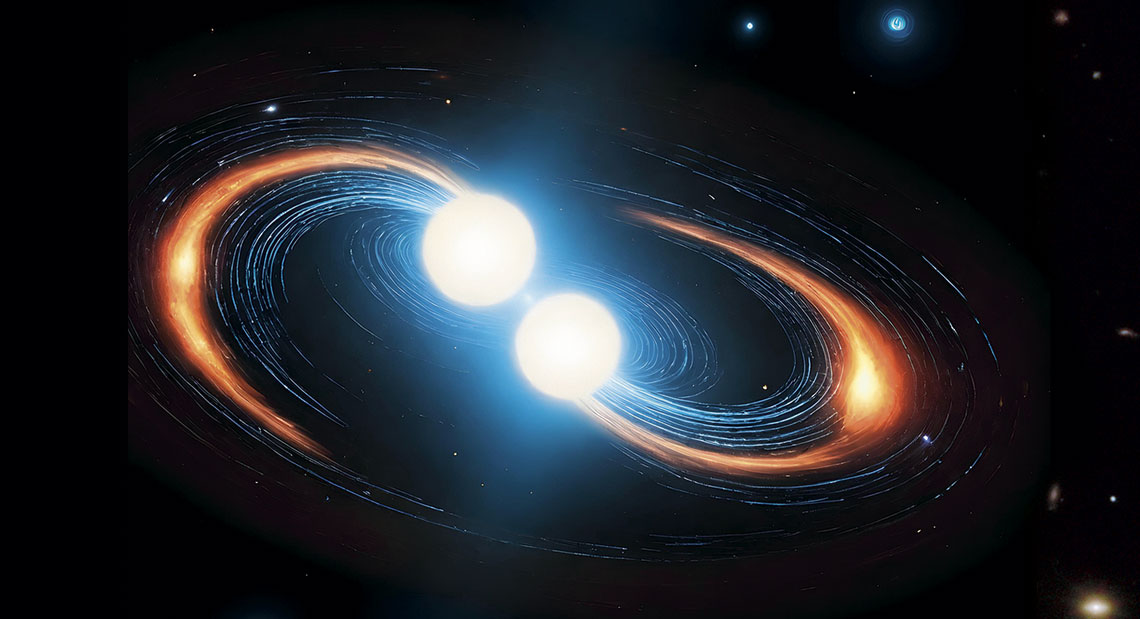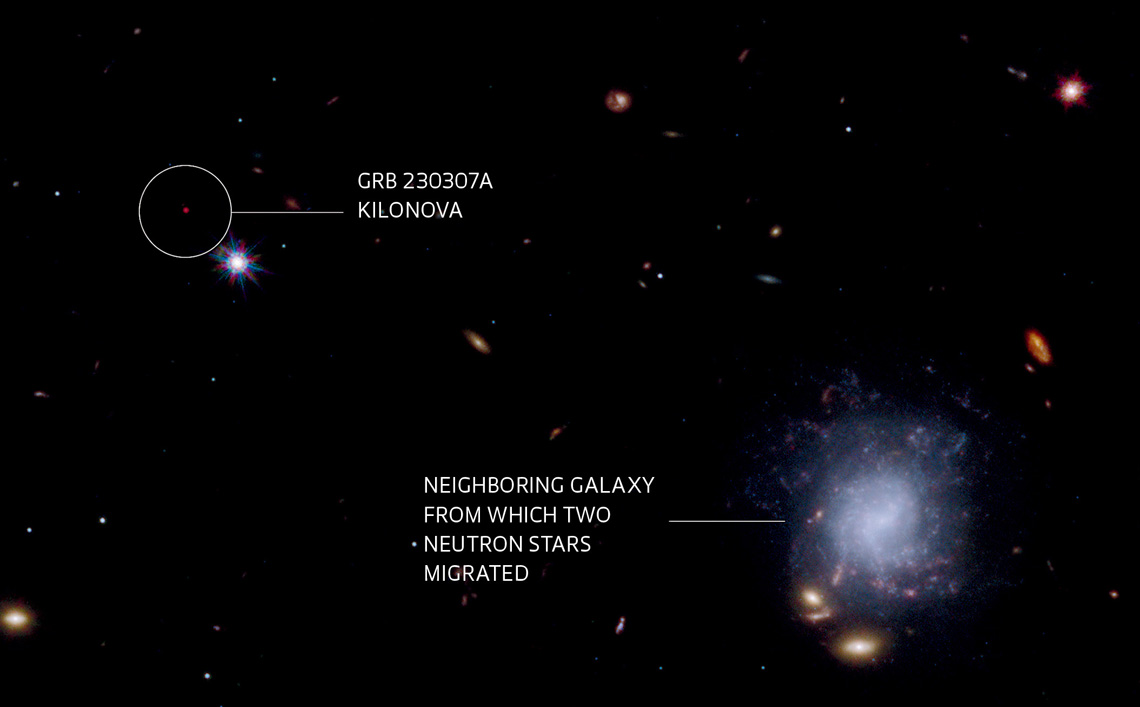An article in Nature published February 21 this year with participation from Brazilian scientists provides further evidence that a gamma-ray burst observed in March 2023 was caused by a rare cosmic event: either the merger of two neutron stars or a neutron star merging with a black hole. The collision and subsequent union of such dense celestial objects is called a kilonova. Considered the second most luminous and energetic gamma-ray burst ever recorded, last year’s event had been the subject of a previous study, also published in Nature, conducted by a different group of astrophysicists and presenting results similar to those of the most recent work.
The explosion associated with a kilonova generates enormous emissions of light energy, especially in the gamma-ray wavelengths, which are invisible to the human eye. Another signature resulting from the union of two neutron stars is the production of chemical elements from the rare earth group, called lanthanides, which are heavier than iron. In space, only an explosion associated with a kilonova would be capable of acting as a rare earth factory. Lanthanides are forged from a process known as neutron capture, which involves radioactive decay and emissions of gamma rays, the most energetic form of light, or photon.
“We found evidence that this kilonova could have produced more stable lanthanides than we initially expected,” says astrophysicist Clécio De Bom, from the Brazilian Center for Physical Research (CBPF). De Bom is one of three Brazilian researchers who coauthored the article, written by an international group of scientists coordinated by Eleonora Troja, from the University of Rome Tor Vergata. The other two Brazilian authors are Martín Makler, also from CBPF, and Felipe Navarete, an astronomer who works on the SOAR telescope, an observation instrument located in Chile and operated by Brazilian and North American universities.
After a kilonova explosion, although the gamma-ray emissions resulting from the merger last for mere seconds, there is also the release of a residual afterglow in other wavelengths, such as optical and infrared, which can last for days or weeks. This is why even telescopes that don’t operate at gamma-ray frequencies, such as the Hubble and James Webb observatories, can be deployed to monitor the afterglow of extremely energetic events. “We observed this kilonova with SOAR at five different times,” says Navarete.

Clara & Sofía López Martín (Freepik) / Alberto J. Castro-Tirado (IAA-CSIC/UMA) Artist’s illustration depicts the collision of the merging starsClara & Sofía López Martín (Freepik) / Alberto J. Castro-Tirado (IAA-CSIC/UMA)
The resulting gamma-ray burst was first recorded on March 7, 2023, by NASA’s Fermi satellite, which is dedicated to observations in this wavelength range. The event, the second most intense of its type ever observed, was named GRB 230307A. The first three letters are an acronym for the English name of the phenomenon, gamma-ray burst (GRB). The numbers refer to the year (23), month (03), and day (07) in which the event occurred. The “A” means it was the first explosion of its kind seen on that date.
In addition to its enormous luminosity, the phenomenon aroused immediate interest in the astrophysicist community due to two other peculiarities: its atypical duration and the region of space from which the explosion originated. The strong pulse of gamma rays lasted for around 35 seconds, which classifies it as a long-lasting explosion, according to the field’s classification. Events of this type that last less than 2 seconds are considered short, while those that exceed this time limit are categorized as long.
The problem is that kilonovae have always been associated with short gamma-ray bursts, while longer-lasting gamma-ray pulses are normally produced by supernovae. The death of massive stars, a process that also generates a strong explosion, is called a supernova. However, astrophysicists from the two independent groups who analyzed GRB 230307A did not find any massive dying stars where the event occurred.
This region is practically empty of objects and is about 130,000 light years from the nearest galaxy. Such a desolate scenario led researchers to propose an explanation for this unusual situation: that a pair of neutron stars had broken away from their mother galaxy and migrated to a neighboring area in space. In the middle of nowhere, the stars merged and generated an astonishing burst of gamma rays lasting more than half a minute.
According to Italian astrophysicist Eleonora Troja, a kilonova and its further development have never been observed for more than a few days. “You need to observe for weeks and months [as they did] to find out which metals were forged in the explosion,” the researcher says in a press release about the study. As there is evidence of the formation of lanthanides in the region associated with GRB 230307A, the researchers argue that there was a merger of two very dense, compact objects there, at least one of which was a neutron star.
Scientific article
YANG, Y. et al. A lanthanide-rich kilonova in the aftermath of a long gamma-ray burst. Nature. Feb. 21, 2024.
